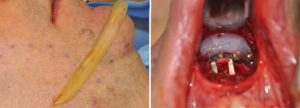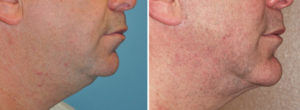Background: Chin augmentation is the most common facial reshaping procedure behind rhinoplasty. While most chin augmentations are done by an implant due to its ‘simplicity’ and ease of the procedure, it is not appropriate for all types of chin augmentation. An implant works best for pure horizontal augmentation that are of moderate amounts of change. (10mms or less)
When the chin is both horizontally and vertically short as well, most chin implants are not designed to provide that type of dimensional change. For small amounts of elongation (1 to 2mms) a standard chin implant can be placed a bit lower on the end of the chin bone but that is a more precarious position that is only stable if multiple screw fixation is used. Such dimensional changes is more reliably achieved with a sliding genioplasty that can provide more significant and stable vertical lengthening as well as horizontal projection.
Soft tissue management is rarely mentioned with chin augmentation given that it is more frequently done in young patients. But full and short necks do exist with short chins, particularly in middle-aged men. So traditional neck procedures such as liposuction, submentoplasty and even over facelifts can be concurrently done to complement the chin augmentation as well as help provide some jawline definition.
Case Study: This younger middle-aged male had long been bothered by having no chin and jawline. He was often referred to as having a double chin. He had a chin implant placed in his twenties, which provided some moderate benefit, but still left him visibly deficient in chin projection. He had a naturally deep labiomental fold crease. His jaw angles were high and indistinct. Now older and heavier he also had developed a fuller neck with an indistinct cervicomental angle.


Case Highlights:
1) A horizontally and vertically short chin can be treated by a sliding genioplasty that brings the bone down at a near 45 degree angle.
2) When further horizontal augmentation is needed that what a sliding genioplasty can provide an overlay implant can be used to provide additional hirozontal augmentation
3) Management of a lax and full neck can be done by concurrent liposuction, submentoplasty or tuckup lower facelift.
Dr. Barry Eppley
Indianapolis, Indiana




